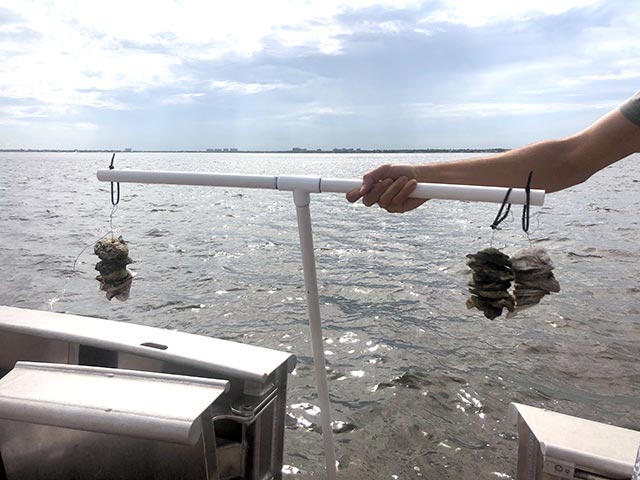Florida Gulf Coast University issued the following announcement on February 24.
Oysters are a small species with a big job. Serving as a natural filtration system, these shellfish help keep water clean. When they’ve done their job and the water is clear, Florida thrives.
A team of researchers from The Water School at Florida Gulf Coast University is studying how to keep these “kidneys of the sea” healthy.

Felix Jose, associate professor of marine science, and Brooks Harp, a member of his research team, use a microscope to count oyster larvae. Photo: James Greco/FGCU.
“Oysters are very efficient in filtering the water. As filter feeders, they help to remove nutrients and contaminants from the water column,” explained Felix Jose, associate professor of marine science.
Jose and a team of students are studying how oyster larvae travel, settle and grow. This process is the backbone of oyster reef restoration.
In a partnership with the Sanibel-Captiva Conservation Foundation, the group conducted a field study in Southwest Florida starting in June 2020. Every two weeks they traveled by boat to 10 different coastal sites, from San Carlos Bay near Fort Myers Beach north to Matlacha Pass between Cape Coral and Pine Island, to collect water samples.
 As filter feeders, oysters help to remove nutrients and contaminants from the water column. Photo submitted.
As filter feeders, oysters help to remove nutrients and contaminants from the water column. Photo submitted.
They also deployed three oyster “stringers” at each site. A stringer consists of 10 oyster shells attached to wire that hangs from a PVC crossbar. The stringers remained there for two weeks, allowing baby oysters to mature and settle.
“Using a pump we filtered out 20 liters of water from each site and collected the larvae,” said Jose. “Then in the lab, we separate and count them using a microscope. It shows how many oyster larvae are in every sample.”

RELATED STORIES
» Alumna dives deep into waterway health
» Water research leads to discoveries on sea-level rise
A major component of the research is looking to see how freshwater releases from Florida’s Lake Okeechobee impact the oyster population. Depending on the amount of water released, flows can flush larvae away and not allow them to settle. Salinity of the water can also be detrimental to the population because oysters can only survive in brackish water.
“If we direct a ton of freshwater toward our waters, the salinity drops,” said Brooks Harp, a team member and FGCU senior majoring in marine science. “Oysters are pretty hardy, but there is a range of salinity that they like. If it’s too fresh, there will be greater death and lower settlement.”

Emma Kelly, who graduated in spring 2021, was part of Felix Jose’s research team collecting oyster larvae in Southwest Florida waters. Photo submitted.
The group’s findings from field monitoring help to calibrate a 3-D computer modeling system developed by Jose that can calculate tides and currents in the Caloosahatchee River, which carries Lake Okeechobee water releases to the Southwest Florida coast. The model is combined with an oyster larval transport model which predicts the movement and settlement of larvae.
The working model helps to guide those wanting to construct artificial reefs for oyster restoration to the right spot within the estuary.
“They can look at our study with certainty and see where they should [deploy a reef],” explained Harp. “There will be a greater chance of success if this study is used as a recommendation.”
The study is in its second year, and Jose says the findings are promising. Results have shown 2021 oyster settlements are more protected than 2020.
“This was a perfect year because no major freshwater releases happened in the spawning season. A healthy proportion of oyster larvae survived, and there is very positive settlement,” explained Jose. “We expect a very good crop of oysters into the next year.”
For students like Harp, the hands-on experience and work in the field has helped shape his path for the future. He encourages students to take advantage of research opportunities. Harp’s proud his work is directly impacting the Southwest Florida area, too. Study findings will be presented at the upcoming Benthic Ecology Meeting to be held at Portsmouth, New Hampshire later this spring.
“In terms for the ecosystem, [oyster reefs] have a significant role to play,” Harp said. “They are supporting a very large variety of animal species in our area, which directly leads to economic benefit. In order to enjoy what Florida has to offer, you need healthy oyster reefs.”

An oyster “stringer” being deployed at a site. It would remain for two weeks, allowing baby oysters to mature and settle. Photo submitted.
Tags: caloosahatchee river, fgcu, florida gulf coast university, lake okeechobee, marine science, Matlacha Pass, oysters, San Carlos Bay, Sanibel-Captiva Conservation Foundation, The Water School at FGCU, Undergraduate research
Original source can be found here.




 Alerts Sign-up
Alerts Sign-up